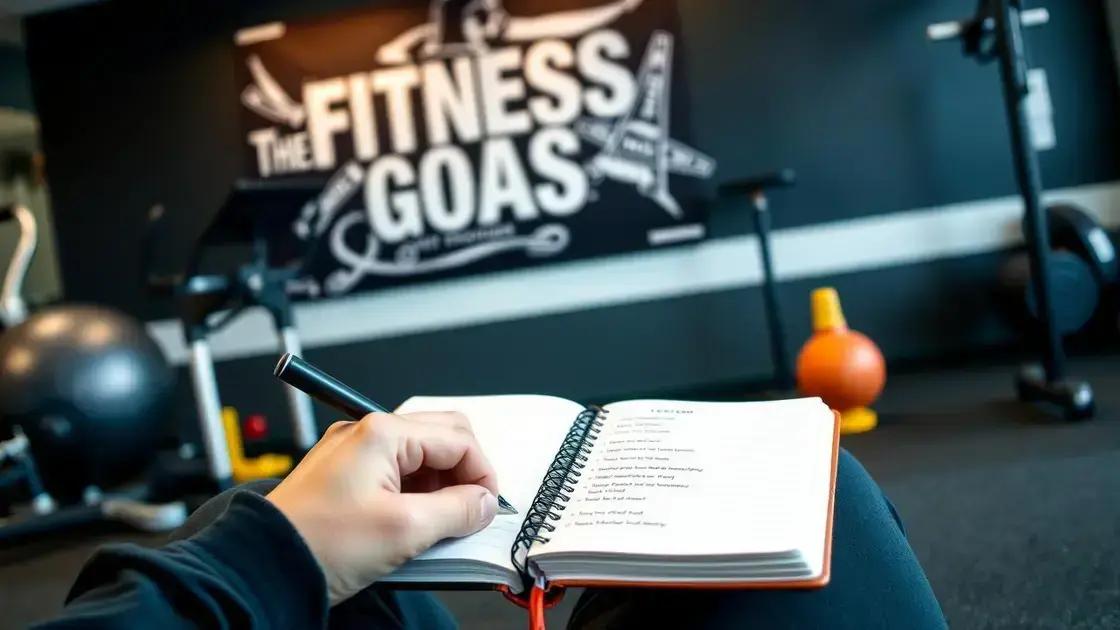To progress from beginner to advanced workouts, assess your fitness level, set realistic SMART goals, implement progressive overload techniques, and stay motivated by changing routines, tracking progress, and having a workout buddy to overcome plateaus.
Are you ready to take your fitness journey to the next level? Understanding how to progress from beginner to advanced workouts is key to achieving your goals. With the right strategies, you can build strength, increase endurance, and transform your routine. In this article, we will guide you through assessing your current fitness level, setting achievable workout goals, implementing progressive overload, and tips for staying motivated as you advance.
Understanding Your Current Fitness Level

To progress in your workouts effectively, you first need to assess your current fitness level. This understanding will help you craft a personalized plan that matches your abilities and goals. Start by considering factors such as your strength, endurance, and flexibility.
Assessing Your Strength
To evaluate your strength, perform a few basic exercises such as push-ups, squats, and lunges. Keep track of how many you can do comfortably. This will give you a good idea of your baseline strength and where you need to improve.
Checking Your Endurance
Endurance can be assessed by doing a simple cardio test. Try running or brisk walking for 1 mile or 15 minutes, and time how long it takes you. Knowing your endurance level will help you establish appropriate cardio workouts moving forward.
Evaluating Your Flexibility
Flexibility is often overlooked but plays a crucial role in overall fitness. A simple test is the sit-and-reach. Sit on the floor with your legs straight and reach towards your toes. Measure how far you can reach. This will highlight areas you might want to focus on to avoid injury.
Creating a Fitness Baseline
Once you’ve assessed your strength, endurance, and flexibility, you can create a fitness baseline. This baseline will guide you in setting realistic goals and tracking your progress. Remember that everyone’s journey is different, so don’t compare yourself to others.
Regularly reassessing your fitness level is essential as you progress. Schedule check-ins every few weeks to define how much you’ve improved. This will keep you motivated and help you adjust your workout plan to continue challenging yourself.
Setting Realistic Workout Goals

Setting realistic workout goals is crucial for success in your fitness journey. Goals keep you focused, motivated, and accountable. They should be specific, measurable, achievable, relevant, and time-bound (SMART).
Specific Goals
Firstly, your goals need to be specific. Instead of saying, “I want to get fit,” decide what that means for you. For example, aim to do 10 push-ups or run 1 mile without stopping.
Measurable Objectives
Next, ensure your goals are measurable. You can track your progress by how many reps you complete or by measuring your time for distance runs. Keep a log to see how far you’ve come.
Achievable Targets
Your goals need to be achievable. While it’s great to aim high, unrealistic targets can lead to frustration. Set short-term goals that build up to your ultimate goals, like increasing your workout frequency over time.
Relevant Aspirations
Make sure your aims are relevant to your overall fitness journey. If your main goal is to gain muscle, focus on strength training rather than solely on cardio.
Time-Bound Goals
Finally, goals should be time-bound. Set deadlines to keep yourself accountable. For instance, aim to run a specific distance within four weeks. This creates a sense of urgency and helps you stay focused.
Regularly review and adjust your goals as needed. As you accomplish smaller goals, you can set new ones. This approach keeps the journey exciting and rewarding.
Implementing Progressive Overload Techniques

Implementing progressive overload techniques is essential for making continuous improvements in your workouts. Progressive overload means gradually increasing the intensity of your workouts. This may involve lifting heavier weights, increasing the number of repetitions, or adding more sets.
Increasing Weight
A straightforward way to apply progressive overload is by increasing the weights you lift. When you find that your current weight feels comfortable, increase it by small amounts, like 5%. This encourages your muscles to adapt and grow stronger.
Increasing Repetitions
Instead of just adding weight, you can also increase the number of repetitions you perform. For example, if you currently do 10 push-ups, add one or two more reps each week. This helps build endurance and strength simultaneously.
Adding More Sets
Another technique is adding more sets to your routine. If you usually do three sets of an exercise, consider increasing to four or five sets. This adds volume to your workout and promotes muscle growth.
Reducing Rest Time
Reducing the rest time between sets can also create a greater intensity. If you currently rest for 60 seconds, try to reduce it to 45 seconds. This increases the challenge and keeps your heart rate up during workouts.
Mixing Up Your Routine
Finally, don’t forget to mix up your exercises. Changing the type of workouts you do will keep your muscles guessing and prevent plateaus. Incorporate different movements or practice new activities like swimming or cycling alongside your usual workouts.
By regularly applying these progressive overload techniques, you can continue to challenge your body and make consistent progress on your fitness journey.
Staying Motivated and Overcoming Plateaus

Staying motivated in your fitness journey is challenging, especially when you hit plateaus. Motivation is vital for progress and helps you push through tough times. Here are some effective strategies to keep you motivated and overcome plateaus.
Set New Goals
When progress slows down, consider setting new goals. Instead of focusing solely on weight loss or muscle gain, think about mastering a new skill. For instance, aim to improve your running speed or learn a challenging yoga pose. This refreshes your routine and keeps you engaged.
Track Your Progress
Keep a workout journal to track your performance. Writing down your achievements, no matter how small, can motivate you to keep going. Seeing how far you’ve come can spark inspiration and help you stay on course.
Change Your Routine
Switching up your workout routine can break the monotony. Try new exercises, classes, or sports. This not only challenges your body but also keeps things interesting. Incorporating variety helps to stimulate your muscles and may reignite your passion for fitness.
Find a Workout Buddy
Having a workout partner can make exercising more enjoyable. A friend can provide encouragement, share accountability, and even introduce you to new activities. Working out together allows you to celebrate each other’s progress and create a support system.
Practice Self-Compassion
Lastly, it’s important to be kind to yourself during tough times. Understand that hitting a plateau is a normal part of the fitness journey. Instead of getting frustrated, practice self-compassion and remind yourself that progress takes time. Celebrate the small wins and recognize your efforts.
By using these strategies, you can maintain your motivation and navigate through plateaus effectively, keeping your fitness journey exciting and productive.
In Summary: Progressing from Beginner to Advanced Workouts
Progressing from beginner to advanced workouts requires understanding your current fitness level and setting realistic goals. By implementing progressive overload techniques, you challenge your body and promote strength gains.
Staying motivated throughout your journey is crucial. Regularly assess your progress, switch up your routine, and set new goals to combat plateaus. Finding a workout buddy and practicing self-compassion will also help you stay on track.
By following these strategies, you can elevate your fitness journey and continue to see improvements, no matter your starting point.
FAQ – Frequently Asked Questions about Progressing from Beginner to Advanced Workouts
How do I assess my current fitness level?
You can assess your fitness level by testing your strength, endurance, and flexibility through simple exercises like push-ups, running, or sit-and-reach.
What are realistic workout goals?
Realistic workout goals should be specific, measurable, achievable, relevant, and time-bound (SMART), such as completing a certain number of reps or running a specific distance.
What is progressive overload?
Progressive overload is the practice of gradually increasing the intensity of your workouts by adding weight, increasing reps, or reducing rest time to stimulate muscle growth.
How can I stay motivated during my fitness journey?
You can stay motivated by setting new goals, tracking your progress, working out with a buddy, and changing your routine to keep things fresh.
What should I do if I hit a plateau?
To overcome a plateau, consider changing your workout routine, increasing the weight or reps you perform, and ensuring you’re resting properly between workouts.
Should I practice self-compassion during my fitness journey?
Yes, self-compassion is important. Recognize that plateaus are normal, and it’s crucial to be patient with yourself while continuing to work toward your goals.












